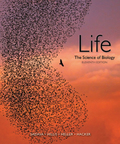
Concept explainers
To review:
The effect of gigas (gi) mutant allele on the pea plant’s flowering, with reference to the data provided in Table 1 below.
Table 1: The effect of gigas mutant allele on the pea plant’s flowering.
|
Strains |
Photoperiod (hours of light provided to the plants) | ||
| 12 h | 16 h | 24 h | |
| Gigas (gi mutant) | 54 nodes | 43 nodes | Only vegetative growth |
| Wild type (WT) | 20 nodes | 16 nodes | 15 |
Introduction:
The flowering of a plant depends on the types of genes that are essential for its flowering. In pea plants, the effects of genes are often studied with the help of grafting. When wild type (WT) is grafted with the mutant type of plant stem, the mobile signals get transferred from one stem to another, thus compensating the absence of a functional allele in the mutant type.
Explanation of Solution
In Table 1, the number of nodes in case of the gi allele is more as compared to the WT, after 12 hours and 16 hours of light exposure. This means that the vegetative growth of plant is more in mutant allele as compared to the WT. When the vegetative growth of a plant is more, the flowering occurs very late because flowering takes place only after the vegetative growth of a plant gets stopped.
After 24 hours of light exposure, only 15 numbers of nodes are noticed in the WT type whereas, in the plants, with gi allele, only the vegetative growth is observed. In the mutant plants, flowering is never observed even after 24 hours of light exposure.
Thus, it can be concluded that from the given table that the mutant allele gi, delays the flowering in the plants, whereas the plants with WT allele undergo the normal period of flowering.
Want to see more full solutions like this?
- Can you explain a brief description of each of the methods used?arrow_forwardWhat are the for phytoglycogen confirmation properties in maize can that can determine the extracted glycogen in the plants. Present it nicely.arrow_forwardCan you answer part a-c if its true or false a) the AP3 and PI show auto- and cross-regulatory interactions, as well as they form obligate heterodimers to carry out the B class gene function. Therefore, if there is no PI expression, AP3 expression alone is not sufficient for establishing the petal and stamen identities. b) Angiosperm is a group of plants whose seeds are borne within a mature ovary (fruit). c) The organ in different organisms under every variety of forms and functions due to evolutionary development from the same or a corresponding part in a common ancestor is homologous.arrow_forward
- Trace the genetic steps in the development of a peanut plant that isresistant to insect larvae (table given). (Hint: You need to useAgrobacterium.)arrow_forwardExplain why loss-of-function hedgehog and smoothened mutations yield the same phenotype in flies, but a loss-of- function patched mutation yields the opposite phenotype.arrow_forwardExplain why crops such as bananas, seedless watermelons, and potatoes are mutants arrow_forward
- the photos below show flowers from two Arabidopsisplants. The plant on the left is wild-type (unmutated); theother carries a mutation that causes its flowers to havesepals and petals instead of stamens and carpels. Themutation inactivated one of the plant's ABC floral identity genes. Refer to Figure 10.8 and decide which gene(A, B, or C) has been inactivatedarrow_forwardYeast cells are grown with galactose as the sole carbon source and ATP levels are abundant. Describe and diagram how GAL1 gene expression will be changed (or unchanged) in 1) a ΔGal3 mutant and 2) a ΔGal4 mutant in comparison to WT. (Δ is a symbol for deletion.) WT: ΔGal3: ΔGal4:arrow_forwardDescribe the Egly precueing experiment. What is the same-object advantage,and how was it demonstrated by Egly’s experiment?arrow_forward
- Concerning the Tools of Genetics Box Analysis ofCell-Cycle Mutants in Yeast:a. Describe how you would use replica plating ofmutagenized, haploid yeast cells to identifytemperature-sensitive (ts) mutations in essentialgenes needed for yeast growth and survival.b. Among the many ts mutations you found in part(a), how would you distinguish mutations in genesneeded for cell-cycle progression from those ingenes needed for other aspects of the life of yeasts?c. If you had a large collection of yeast cell-cyclemutants, how would you determine which of themutations are in the same gene and which are indifferent genes?arrow_forwarda. draw the relevant plant chromosomes in both plants b. explaint he two different ratiosarrow_forwardplease explain if it would be elongated or shortened expression! I know double mutant epistasis is always downstream> upstream but if upstream gene controls downstream, what happens?arrow_forward
 Biology: The Dynamic Science (MindTap Course List)BiologyISBN:9781305389892Author:Peter J. Russell, Paul E. Hertz, Beverly McMillanPublisher:Cengage Learning
Biology: The Dynamic Science (MindTap Course List)BiologyISBN:9781305389892Author:Peter J. Russell, Paul E. Hertz, Beverly McMillanPublisher:Cengage Learning
